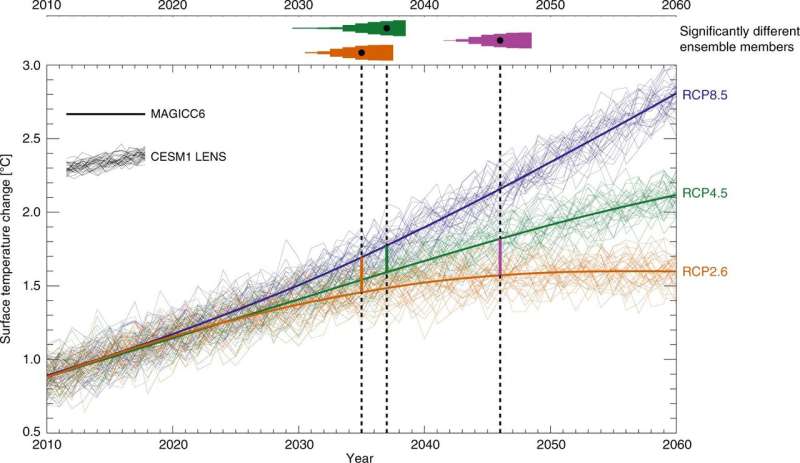Emergence of a temperature signal when going from one RCP emissions pathway to another. Thick lines show calculations from MAGICC6. Thin lines show evolutions of interannual variability of global mean surface temperature, extracted from the CESM1 LENS. Triangles above the graphs indicate the number of ensemble members where the temperature difference between the RCPs is significant, when accounting for internal variability. Credit: Nature Communications (2020). DOI: 10.1038/s41467-020-17001-1
A trio of researchers at the CICERO Center for International Climate Research in Oslo, Norway, has found evidence that it could take decades for the planet to start cooling after human greenhouse gas emissions are reduced. In their paper published in the journal Nature Communications, B. H. Samset, J. S. Fuglestvedt and M. T. Lund describe the factors that went into the model and its results.
As the planet continues to heat up due to human-caused greenhouse gas emissions, scientists continue to try to predict how the planet will respond. In this new effort, the researchers wondered what might happen if the people of the world finally saw the light and made serious efforts to reduce greenhouse gas emissions.
The work involved using multiple climate models to determine how the planet would react to different levels of emission reductions, and also to reductions in different types of emissions.
The researchers found that only reductions in carbon dioxide would result in reversing the ongoing global warming trend—and it would take a long time. But cutting emissions of other gasses is also important; without such reductions, the planet would take much longer to cool. In a best-case scenario, they programmed the model to represent severe emission restrictions (near zero) starting this year. The model showed it would take until 2033 before the planet started to respond in a positive way. And when they programmed the model to represent the world reaching RUCP2.6 this year (a climate scenario deemed by many in the field to represent an achievable emissions reduction), there were no positive changes until 2047. If emissions were reduced by 5 percent each year, we would see some results by 2044.
The researchers acknowledge that the results shown by their model cannot be used as a predictor of actual events, though they suggest it does give us a glimpse of what humanity is up against—and shows in a very powerful way that time is of the essence. The longer we wait to drastically reduce emissions, the longer it will take to recover from the damage that we have done.
More information: B. H. Samset et al. Delayed emergence of a global temperature response after emission mitigation, Nature Communications (2020). DOI: 10.1038/s41467-020-17001-1
Journal information: Nature Communications
© 2020 Science X Network
























